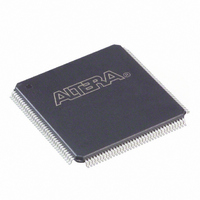EPF6016TC144-3 Altera, EPF6016TC144-3 Datasheet - Page 15

EPF6016TC144-3
Manufacturer Part Number
EPF6016TC144-3
Description
IC FLEX 6000 FPGA 16K 144-TQFP
Manufacturer
Altera
Series
FLEX 6000r
Datasheet
1.EPF6010ATC100-3N.pdf
(52 pages)
Specifications of EPF6016TC144-3
Number Of Logic Elements/cells
1320
Number Of Labs/clbs
132
Number Of I /o
117
Number Of Gates
16000
Voltage - Supply
4.75 V ~ 5.25 V
Mounting Type
Surface Mount
Operating Temperature
0°C ~ 85°C
Package / Case
144-TQFP, 144-VQFP
Lead Free Status / RoHS Status
Contains lead / RoHS non-compliant
Total Ram Bits
-
Other names
544-1282
Available stocks
Company
Part Number
Manufacturer
Quantity
Price
Company:
Part Number:
EPF6016TC144-3
Manufacturer:
ALTERA
Quantity:
48
Company:
Part Number:
EPF6016TC144-3
Manufacturer:
SANYO
Quantity:
47
Company:
Part Number:
EPF6016TC144-3
Manufacturer:
ALTERA
Quantity:
1 066
Part Number:
EPF6016TC144-3
Manufacturer:
ALTERA/阿尔特拉
Quantity:
20 000
Company:
Part Number:
EPF6016TC144-3N
Manufacturer:
ALTERA42
Quantity:
1 341
Part Number:
EPF6016TC144-3N
Manufacturer:
ALTERA/阿尔特拉
Quantity:
20 000
FLEX 6000 Programmable Logic Device Family Data Sheet
Normal Mode
The normal mode is suitable for general logic applications, combinatorial
functions, or wide decoding functions that can take advantage of a
cascade chain. In normal mode, four data inputs from the LAB local
interconnect and the carry-in are inputs to a 4-input LUT. The Altera
software automatically selects the carry-in or the DATA3 signal as one of
the inputs to the LUT. The LUT output can be combined with the cascade-
in signal to form a cascade chain through the cascade-out signal.
Arithmetic Mode
The arithmetic mode is ideal for implementing adders, accumulators, and
comparators. An LE in arithmetic mode uses two 3-input LUTs. One LUT
computes a 3-input function; the other generates a carry output. As shown
in
Figure
7, the first LUT uses the carry-in signal and two data inputs from
the LAB local interconnect to generate a combinatorial or registered
output. For example, when implementing an adder, this output is the sum
of three signals: DATA1, DATA2, and carry-in. The second LUT uses the
same three signals to generate a carry-out signal, thereby creating a carry
chain. The arithmetic mode also supports simultaneous use of the cascade
chain.
The Altera software implements logic functions to use the arithmetic
mode automatically where appropriate; the designer does not have to
decide how the carry chain will be used.
Counter Mode
The counter mode offers counter enable, synchronous up/down control,
synchronous clear, and synchronous load options. The counter enable and
synchronous up/down control signals are generated from the data inputs
of the LAB local interconnect. The synchronous clear and synchronous
load options are LAB-wide signals that affect all registers in the LAB.
Consequently, if any of the LEs in a LAB use counter mode, other LEs in
that LAB must be used as part of the same counter or be used for a
combinatorial function. In addition, the Altera software automatically
places registers that are not in the counter into other LABs.
The counter mode uses two 3-input LUTs: one generates the counter data
and the other generates the fast carry bit. A 2-to-1 multiplexer provides
synchronous loading, and another AND gate provides synchronous
clearing. If the cascade function is used by an LE in counter mode, the
synchronous clear or load will override any signal carried on the cascade
chain. The synchronous clear overrides the synchronous load.
Altera Corporation
15














